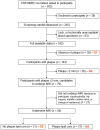Red Blood Cell Eicosapentaenoic Acid Inversely Relates to MRI-Assessed Carotid Plaque Lipid Core Burden in Elders at High Cardiovascular Risk
- PMID: 28930197
- PMCID: PMC5622796
- DOI: 10.3390/nu9091036
Red Blood Cell Eicosapentaenoic Acid Inversely Relates to MRI-Assessed Carotid Plaque Lipid Core Burden in Elders at High Cardiovascular Risk
Abstract
Supplemental marine omega-3 eicosapentaenoic acid (EPA) has an anti-atherosclerotic effect. Clinical research on EPA supplied by the regular diet and atherosclerosis is scarce. In the framework of the PREvención con DIeta MEDiterránea (PREDIMED) trial, we conducted a cross-sectional study in 161 older individuals at high vascular risk grouped into different stages of carotid atherosclerosis severity, including those without ultrasound-detected atheroma plaque (n = 38), with plaques <2.0 mm thick (n = 65), and with plaques ≥2.0 mm (n = 79). The latter were asked to undergo contrast-enhanced 3T magnetic resonance imaging (MRI) and were subsequently grouped into absence (n = 31) or presence (n = 27) of MRI-detectable plaque lipid, a main feature of unstable atheroma plaques. We determined the red blood cell (RBC) proportion of EPA (a valid marker of long-term EPA intake) at enrolment by gas chromatography. In multivariate models, EPA related inversely to MRI-assessed plaque lipid volume, but not to maximum intima-media thickness of internal carotid artery, plaque burden, or MRI-assessed normalized wall index. The inverse association between EPA and plaque lipid content in patients with advanced atherosclerosis supports the notion that this fatty acid might improve cardiovascular health through stabilization of advanced atheroma plaques.
Keywords: atherosclerosis; diet; fish; imaging; omega-3.
Conflict of interest statement
Philip C. Calder is an advisor to Pronova BioPharma. Jordi Salas-Salvadó has received research funding and is a non-paid member of the scientific advisory committee of the International Nut Council. Emilio Ros has received research funding from the California Walnut Commission and is also a non-paid member of its scientific advisory committee. No other authors declare a conflict of~interest.
Figures
References
-
- Piepoli M.F., Hoes A.W., Agewall S., Albus C., Brotons C., Catapano A.L., Cooney M.T., Corrà U., Cosyns B., Deaton C., et al. 2016 European Guidelines on cardiovascular disease prevention in clinical practice: The Sixth Joint Task Force of the European Society of Cardiology and Other Societies on Cardiovascular Disease Prevention in Clinical Practice (constituted by representatives of 10 societies and by invited experts) Developed with the special contribution of the European Association for Cardiovascular Prevention & Rehabilitation (EACPR) Eur. Heart J. 2016;37:2315–2381. - PMC - PubMed
-
- Sannino A., Brevetti L., Giugliano G., Scudiero F., Toscano E., Mainolfi C., Cuocolo A., Perrino C., Stabile E., Trimarco B., et al. Non-invasive vulnerable plaque imaging: How do we know that treatment works? Eur. Heart J. Cardiovasc. Imaging. 2014;15:1194–1202. doi: 10.1093/ehjci/jeu097. - DOI - PubMed
-
- Siscovick D.S., Barringer T.A., Fretts A.M., Wu J.H.Y., Lichtenstein A.H., Costello R.B., Kris-Etherton P.M., Jacobson T.A., Engler M.B., Alger H.M., et al. Omega-3 Polyunsaturated Fatty Acid (Fish Oil) Supplementation and the Prevention of Clinical Cardiovascular Disease: A Science Advisory from the American Heart Association. Circulation. 2017 doi: 10.1161/CIR.0000000000000482. - DOI - PMC - PubMed
MeSH terms
Substances
LinkOut - more resources
Full Text Sources
Other Literature Sources
Medical
Research Materials



